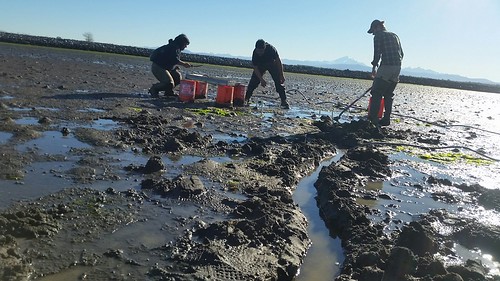
The annual White House Tribal Nations Conference provides tribal leaders from the 567 federally recognized tribes the opportunity to interact directly with high-level federal government officials and members of the White House Council on Native American Affairs. This guest blog describes how USDA’s National Institute of Food and Agriculture (NIFA) supports tribal food sovereignty and economic growth.
By Andres Quesada, associate director, National Indian Center for Marine Environmental Research and Education, Northwest Indian College
Over recent decades there has been a steady decline of the Manila clam on the tidal flats of the Lummi Reservation just outside of Bellingham, Washington. The loss of this important food source directly impacts tribal food security and sovereignty of the Lummi people.
My fellow researcher, Dr. Marco Hatch, and I have teamed up with Dr. Andrew Thurber from Oregon State University to study what is causing the clam population to decline. With the support of NIFA research grants we have identified two possible causes: altered sulfur cycling and changes in the clam’s food supply.
Hydrogen sulfide is a compound that is toxic even in low concentrations to most animals. Sulfide can form on tidal flats when bacteria breaks down food sources and exhausts the oxygen supply. While many clams have found ways to tolerate hydrogen sulfide, it can still impact the ability of young clams to grow to harvestable adults. Our goal is to understand the role of sulfide in limiting the clam populations to devise effective management schemes by identifying the ecological mechanism that limits their productivity.
Manila clams are suspension feeders, meaning they filter the water and surface sediments for food items such as plankton, detritus and bacteria. Many factors influence the abundance of these various food sources seasonally, in both quantity and quality, and this can limit a population. By learning what clams eat seasonally we hope to better understand the link between food supply and clam survivorship.
Northwest Indian College students are using biomarkers, including stable isotope and fatty acids, to identify what the clams eat and how that varies throughout the year. Over the course of this project, the students are learning how to collect and prepare samples for analysis on a variety of instruments, including gas chromatograph-mass spectrometers and isotope ratio mass spectrometers; interpret data; and apply cutting-edge food-chain models.
To date, the project has directly trained Native scholars in the field and engaged 20 in the classroom. In addition, more than 40 Native middle and high school students have learned about the project through outreach events.
By the end of this project we will better understand what is impacting the Manila clam. In addition to preserving a vital food source, these projects will protect and grow revenue for the Lummi commercial and subsistence clam diggers while providing hands-on experiences from the field to the lab for many students.
